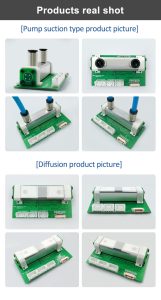-
How does the gas detector detect the plant environment
- In industrial and agricultural settings, monitoring the plant environment is essential for maintaining a safe and productive workspace. Gas detectors are widely used to detect and measure various gases in the plant environment. These dete……
- Chat Online
-
Description
In industrial and agricultural settings, monitoring the plant environment is essential for maintaining a safe and productive workspace. Gas detectors are widely used to detect and measure various gases in the plant environment. These detectors play a crucial role in identifying potentially hazardous gas leaks, ensuring workplace safety, and optimizing plant operations. In this article, we will explore the working principle of gas detectors and how they effectively detect and monitor the plant environment.

I. Working Principle of Gas Detectors:
Gas detectors are designed to detect the presence and concentration of gases in the air. They utilize different sensing technologies to identify specific gases and provide real-time data on their levels. The most common gas detection technologies include:
Catalytic Sensors:
Catalytic sensors work based on the principle of catalytic oxidation.
They consist of a sensing element coated with a catalyst material that reacts with combustible gases.
When a combustible gas comes into contact with the sensor, it undergoes a chemical reaction that produces heat.
The change in temperature is measured and converted into an electrical signal, indicating the presence of the gas.
Electrochemical Sensors:
Electrochemical sensors use electrodes immersed in an electrolyte solution to detect gases.
When a gas molecule interacts with the electrode, a chemical reaction occurs, generating an electrical current.

The magnitude of the current is proportional to the gas concentration and is measured to determine the gas level.
Infrared Sensors:
Infrared sensors operate by detecting the absorption of infrared radiation by specific gases.
They emit infrared light at specific wavelengths and measure the amount of light absorbed by the target gas.
The decrease in transmitted light intensity indicates the presence and concentration of the gas.
Photoionization Detectors (PID):
PID sensors employ ultraviolet (UV) light to ionize gas molecules, creating a measurable current.
The ionization current is proportional to the gas concentration and is used to determine its level.
II. Parameters Monitored by Gas Detectors:
Gas detectors can detect a wide range of combustible gases such as methane, propane, and hydrogen.
By monitoring the concentration of combustible gasespotential fire or explosion risks can be identified and mitigated.
Toxic Gases:
Toxic gases like carbon monoxide, hydrogen sulfide, and ammonia pose health hazards in industrial environments.
Gas detectors equipped with appropriate sensors provide early warnings for toxic gas leaks, allowing workers to evacuate or take necessary precautions.
Oxygen Levels:
Low oxygen levels can lead to asphyxiation, especially in confined spaces.
Gas detectors equipped with oxygen sensors monitor the oxygen concentration in the air to ensure a safe working environment.
Environmental Factors:
Gas detectors may also monitor environmental factors such as temperature and humidity, which can affect plant operations and worker comfort.
III. Steps to Use Gas Detectors:
Choose gas detectors that are suitable for the specific gases to be monitored in the plant environment.
Consider factors such as detection range, accuracy, response time, and any specific requirements for the industry.
Installation:
Install gas detectors in strategic locations where gas leaks are likely to occur.
Follow manufacturer guidelines for proper sensor placement and mounting.
Calibration:
Calibrate the gas detectors regularly to ensure accurate readings.
Calibration involves exposing the sensors to known gas concentrations and adjusting them to match the expected values.
Alarm Settings:
Set appropriate alarm thresholds for each gas being monitored.
When gas concentrations exceed the predefined limits, alarms will sound, notifying workers of potential hazards.
Data Collection and Analysis:
Gas detectors are typically connected to a data logging or monitoring system.
The system records and analyzes the gas concentration data, allowing for trend analysis and identification of potential issues.
Maintenance and Testing:
Regularly inspect and maintain gas detectors according to manufacturer guidelines.
Conduct functional tests to ensure proper sensor operation and alarm functionality.
IV. Benefits of Gas Detectors in the Plant Environment:
Early Warning System:
Gas detectors provide an early warning system, allowing workers to take necessary precautions before gas concentrations reach dangerous levels.
Safety Assurance:
By continuously monitoring the plant environment, gas detectors help maintain a safe working environment and reduce the risk of accidents.
Compliance with Regulations:
Gas detection is often a requirement for regulatory compliance in industries dealing with potentially hazardous gases.
Optimization of Plant Operations:
Gas detectors help optimize plant operations by identifying and rectifying gas leaks promptly, reducing downtime and improving efficiency.
Conclusion:
Gas detectors play a critical role in maintaining a safe and productive plant environment. By utilizing different sensing technologies, gas detectors can effectively detect and monitor various gases, including combustible gases, toxic gases, and oxygen levels. With proper sensor selection, installation, calibration, and alarm settings, gas detectors provide an early warning system, ensuring worker safety and compliance with regulations. Regular maintenance and testing further enhance their reliability and effectiveness. By incorporating gas detectors into plant operations, industries can optimize productivity while prioritizing the safety and well-being of their workforce.
-
Recommend:
-
-
How does the gas detector detect the plant environment
In industrial and agricultural settings, monitoring the pla…
-
The Role of Gas Sensors in Enhancing Workplace Safety
exposure to toxic gases can be particularly dangerous and e…
-
How Gas Sensors are Revolutionizing Indoor Air Quality Monitoring
allergies, and even more severe conditions. As a result, th…
-
How does the gas detector detect gas?
However, not all gas detectors are the same, as different m…
-
 : +86 155 8830 2704
: +86 155 8830 2704 : jxdziot@gmail.com
: jxdziot@gmail.com
